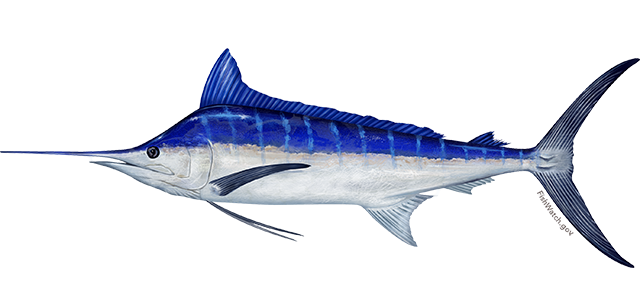Virginia Beach Blue Marlin fishing
Blue Marlin Other Names: Aguja Azul

Physical description:
The Atlantic and Pacific specimens are nearly identical in appearance. The back and upper portions of the body are dark, cobalt blue in color, including the first dorsal fin. The lower portion has a silver-white color. In many cases, there are up to 15 vertical stripes, consisting of small dots and narrow bars, with a light cobalt blue color. The principal way to distinguish blue marlin from their relatives is to examine the shape of the dorsal fin tip, which is more pointed on blue marlin. In addition, the spots found on the fins of most marlin are absent on the blue marlin.
Range:
Blue marlin can be found in tropical and warm temperate waters around the globe, mostly in the Atlantic, Pacific and Indian Oceans. It is the most tropical of the billfish and is often found in waters near the equator.
Feeding Habits:
Blue marlin feed primarily near the surface, though they occasionally dive to deeper water to feed, depending on where their prey is found. Their diet consists mostly of fish and other sea life found near the surface and is highly dependent upon location. This diet can include tuna, mackerel, squid, octopus and any number of fish species indigenous to the environment.
Sporting Qualities:
Most believe Blue Marlin are the most sought after of all the ocean sport fish. A super strong and powerful bill-fish, blue marlin will fight hard and run fast for many hours on end, especially when you are hooked up to a very large marlin. They can suddenly dive to deep water and can make wild jumps like some type of fish acrobatic. With impressive endurance, it is not uncommon to see a hooked fish make up to 40 or more spectacular jumps. This fish can be a tough test of an anglers deep sea fishing skills.
Habitat:
Very little is known about the biology of the blue marlin including their migrations and spawning habits. They are known to be a highly mobile species that travels the warm ocean currents with the seasons in search of comfortable water temperatures. This species inhabits depths up to about 600 feet and water temperatures between 70 and 86 F. They are primarily an offshore species found along the edges of continental shelves, near oceanic mountains, underwater canyons, especially near a warm ocean current.



